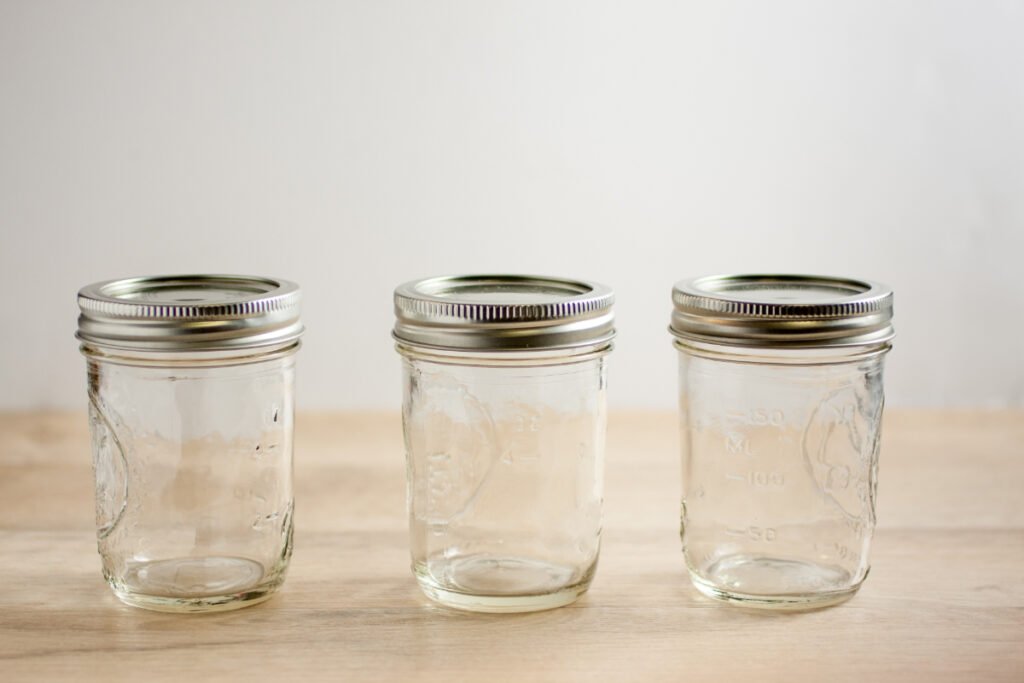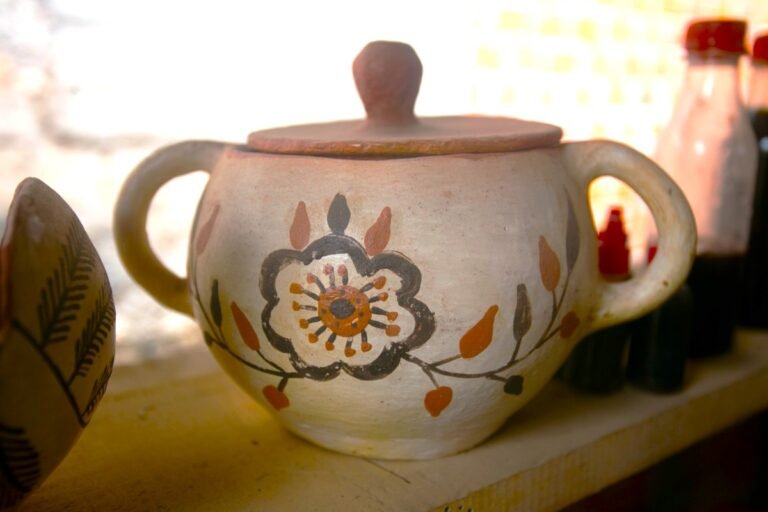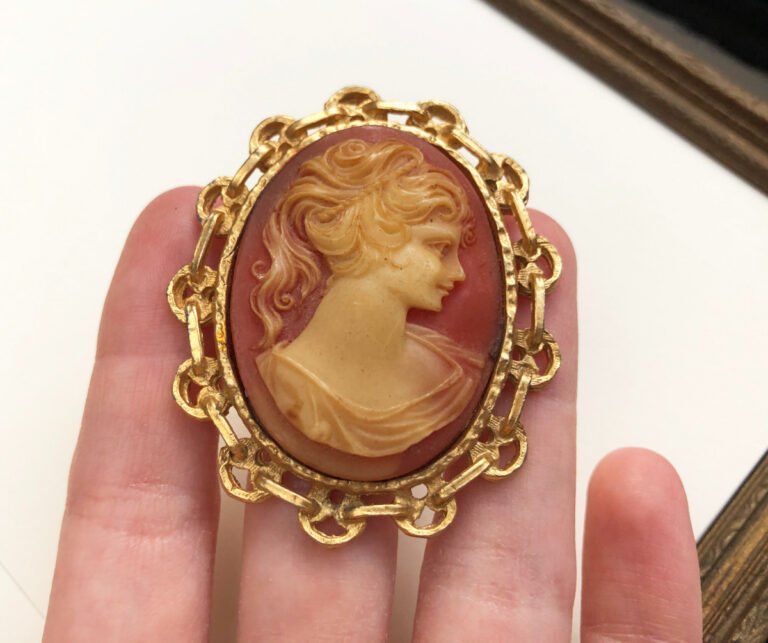Those old Mason jars with rusty zinc lids? They are one of collectors’ favorite vintage glassware pieces to collect. And the fact that almost every household has these old charming jars on their shelves.
But here’s what most people don’t realize: not all old-looking Mason jars are worth the same. Some are worth hundreds of dollars, while others might fetch just a few bucks. The difference? Knowing exactly what to look for.
This guide not only lists some of the rarest old Mason jars but will also help you understand how to spot an authentic jar and what features really mark a valuable find!
17 Rare Old Mason Jars That Are Worth a Lot of Money (With Values)
Whether you’re collecting or selling your old mason jars, don’t miss finding these rare pieces; they’re worth a LOT today!
1. Amber Mason’s Patent Consolidated Fruit Jar

- Brand: Consolidated Fruit Jar Company
- Color: Amber
- Embossment/Marking: Mason’s/CJ/Patent/Nov 30th/1858
The dark brown Mason jars are collectible on their own, and this is a great example of that! What’s more exciting about this jar is that it’s an authentic Mason’s Patent Nov 30th 1858 jar made by Consolidated Fruit Jar Company – see that “CJ” embossing at the front!
The Consolidated Fruit Jar Company operated from 1878-1882, making this jar super antique and rare. Amber jars, especially in good condition, are quite rare to find – so you can expect their worth to be $200-$800+.
Remember This: The date “1858” doesn’t always imply that the jar was made in that year. It’s Mason’s Patent date, and hundreds of companies made jars bearing this date for over 50+ years after John Landis Mason’s original patent.
2. Antique Moores Pint Mason Jar
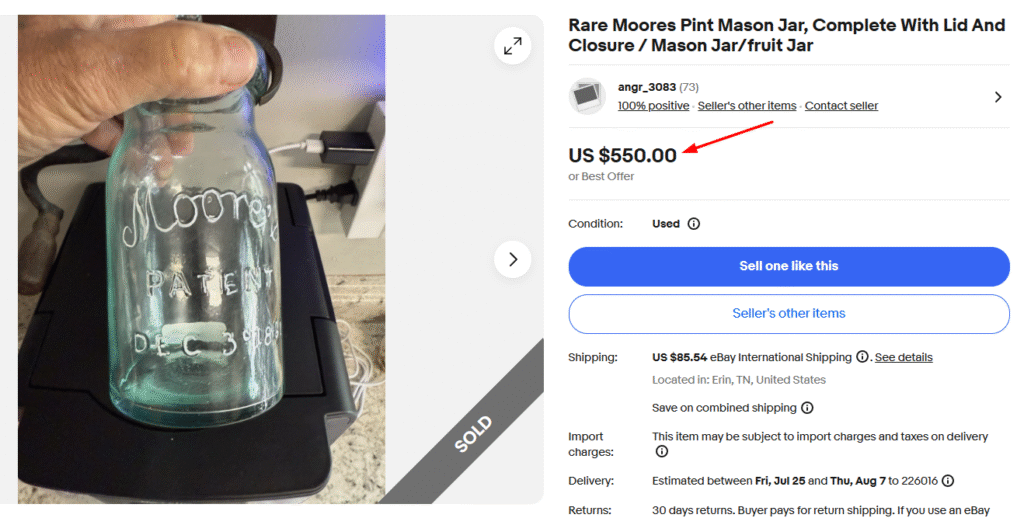
- Brand: Moore’s
- Color: Aqua
- Embossment/Marking: “Moore’s/Patent/Dec 30th 1861”
Moores’ Patent jars are incredibly desirable today, that’s why this example with its complete original closure system realized a whopping $550! It has a unique clamp top finish with an applied top, making it rare.
You can easily spot these jars by the “Moore’s” and “Patent/Dec 30th 1861” embossing on the front and bottom! Such rare Mason patent variations with unique closures and original hardware are almost museum-quality antiques, selling for $200-$600 or more!
3. Rare Brown Amber Mason’s Patent Jar
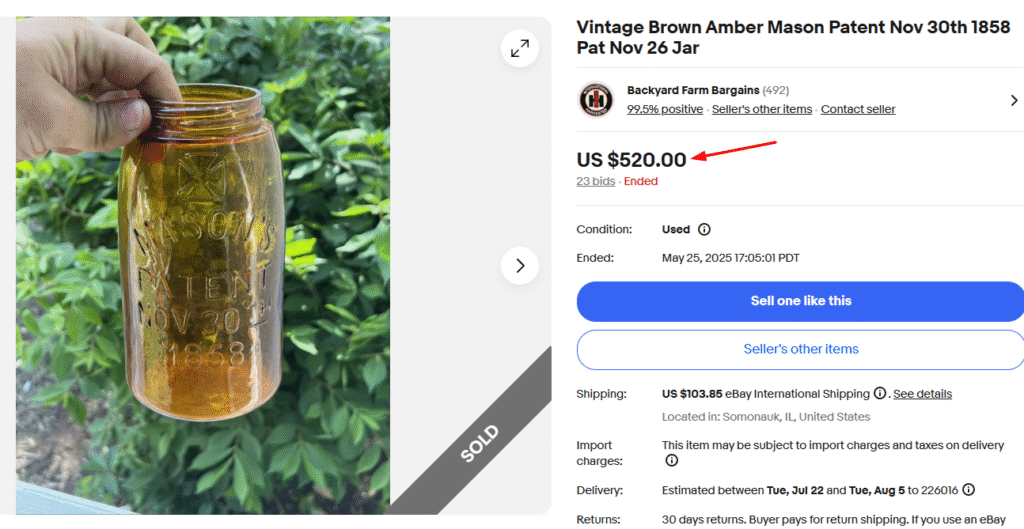
- Brand: Unbranded
- Color: Light Amber
- Embossment/Marking: Mason’s/Patent/Nov 30th/1858
Another gorgeous amber Mason patent jar, but this one is an early piece bearing a cross embossment above the “Mason’s” text! The rich brown amber color makes this particularly desirable; no wonder it sold for $520, that too, without the jar.
Amber and green are among the rarest colors, and can make antique Mason jars worth $300+ easily! Another example is this yellow-green jar bought for over $560!
4. Kerr Anniversary Self Sealing Mason Jar with Factory Error
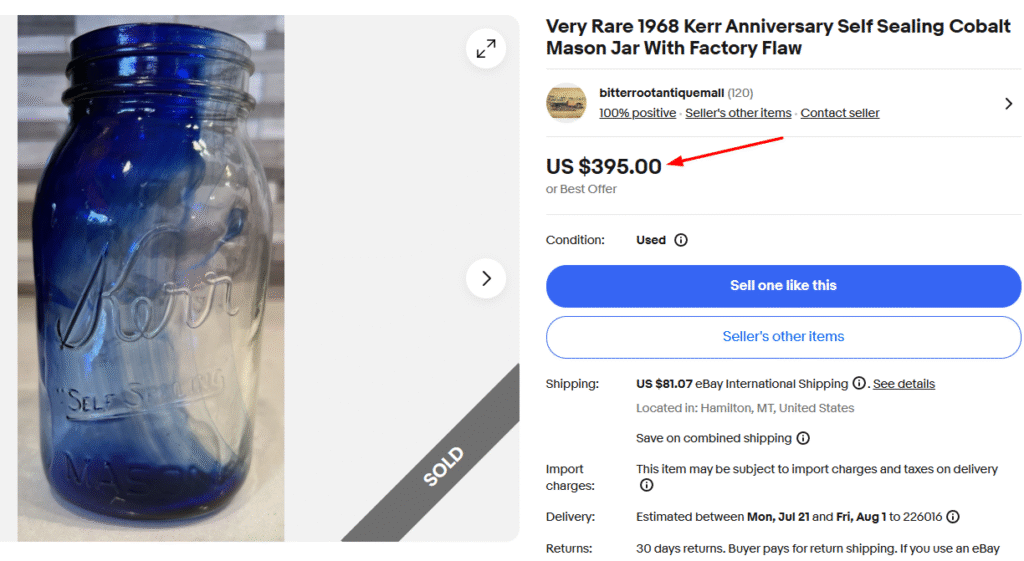
- Brand: Kerr
- Color: Clear & Dark Blue
- Embossment/Marking: Kerr/Self Sealing/Mason
Cobalt blue is one of the most sought-after colors for Mason jars! But this antique Kerr Mason jar is much more than that! It features a unique cobalt blue and clear streaked glass body.
Second, this has a manufacturing error – some cobalt glass “dripped” across the jar during manufacturing. This created a small divot on the outside, a drop on the inside, and a thin glass string across the interior. There’s also a dent along the seam.
Besides, it’s a 1968 anniversary jar, making it even more special as these were likely made in limited quantities to commemorate Kerr’s history. All these features make this jar super rare and justify the steep ask of $395!
5. Olive Trademark Lightning Mason Fruit Jar
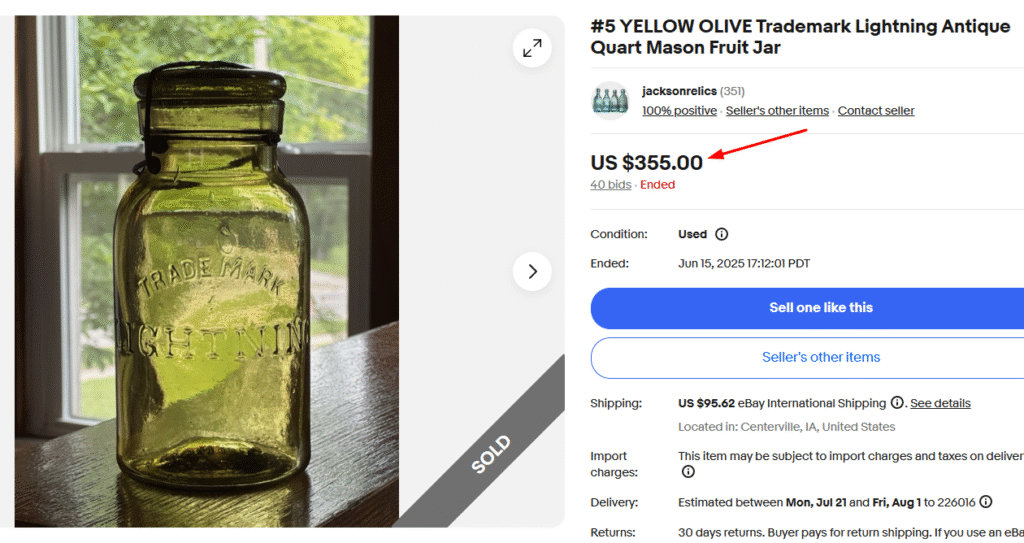
- Brand/Maker: Henry W. Putnam
- Color: Light Olive Green
- Embossment/Marking: Trademark/Lightning
Three features make this Mason jar super rare and valuable: the gorgeous yellow-olive color, the full wire bail top seal using a straddle lip glass lid, and the “Trademark Lightning” embossing!
In some variations, you may also find “PUTNAM” embossing, along with a mold number. I’ve also seen Trademark Lightning jars with the initials “H.W.P” for Henry W. Putnam.
Lightning jars, named so for their super quick to open wire bail mechanism, in rare colors like this are incredibly valuable! Trade Mark jars are particularly worth more!
6. Olive Amber Ball Perfect Mason Jar
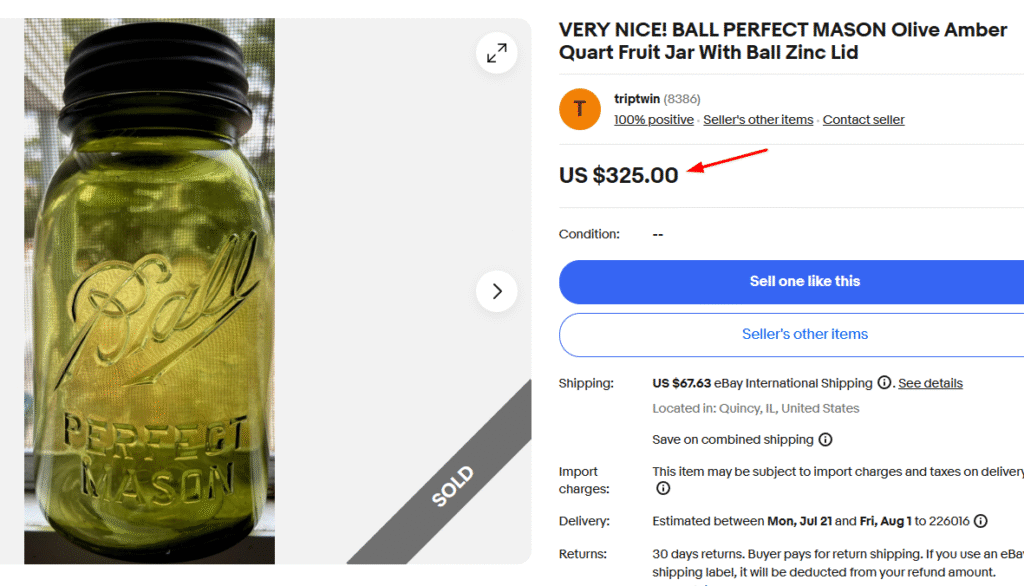
- Brand: Ball Corporation
- Color: Olive Amber
- Embossment/Marking: Ball/Perfect Mason
Ball Perfect Mason jars in rare colors like olive amber command high prices, sometimes reaching $200-350+ as in this example! Most Ball jars are common aqua blue, but rare colors like this olive amber make collectors’ hearts race.
What makes this worth the price is the original metal screw-top lid that seems to be in good condition, adding to the value!
7. Sun Barstow Aqua Clamp Mason Jar
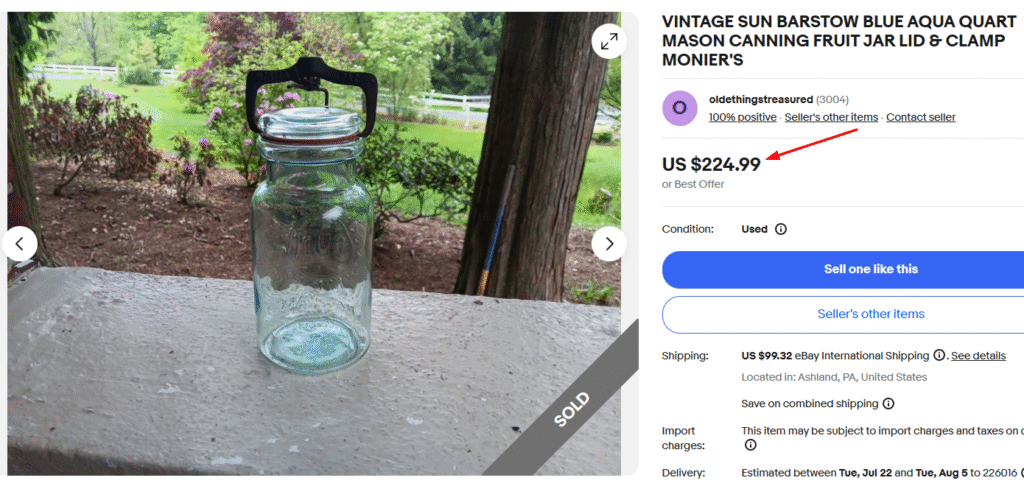
- Brand: JP Barstow
- Color: Amber
- Embossment/Marking: “Sun/Trade Mark”
This rare Sun Barstow Mason jar is a perfect example of how popular jars from small regional companies were! It features a unique wire clamp and glass lid closure, making it antique and rare in itself!
You can spot this jar by the clear sun-shaped embossed motif encircling the “SUN” text and the “JP Barstow” marking on the bottom! You may also find some numbers on the metal clamp.
Unique Mason jars like these, especially with the original clamp mechanism, are collectors’ dream- they easily purchase these finds for $150-$250 or more!
8. The Mason’s Improved Mason Jar
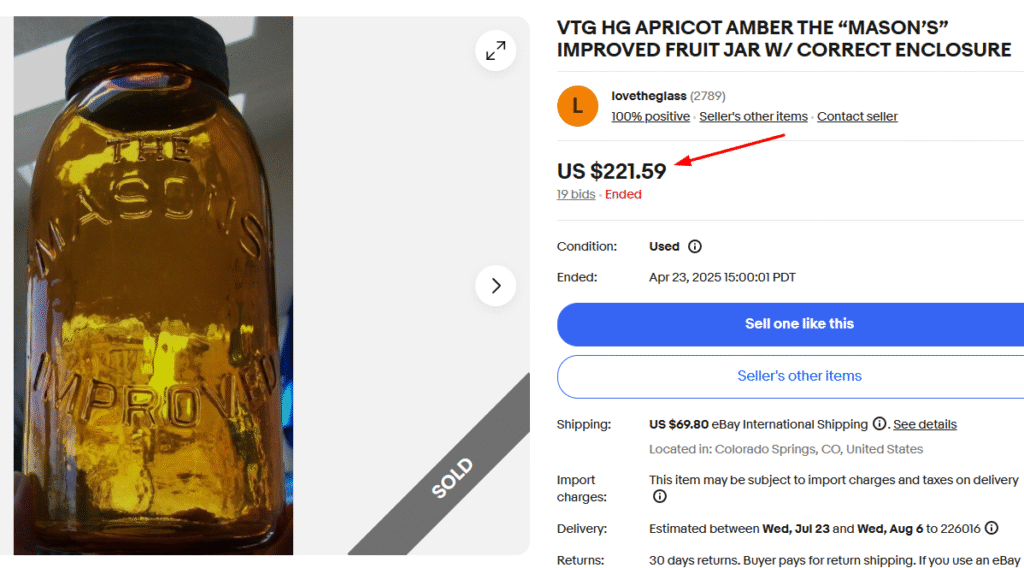
- Brand: Unbranded
- Color: Amber
- Embossment/Marking: The/Masons/Improved
This is a Mason’s Improved jar! Why improved? Because they feature an improved glass lid and metal band system. These jars were among John Mason’s later innovations, made to offer better sealing!
While the design itself is desirable, the apricot amber color makes this jar even rarer and more valuable, as there are only a few specimens in that color! This piece sold for over $220, with an average price ranging from $120-$250!
9. Dark Purple Mason Fruit Jar
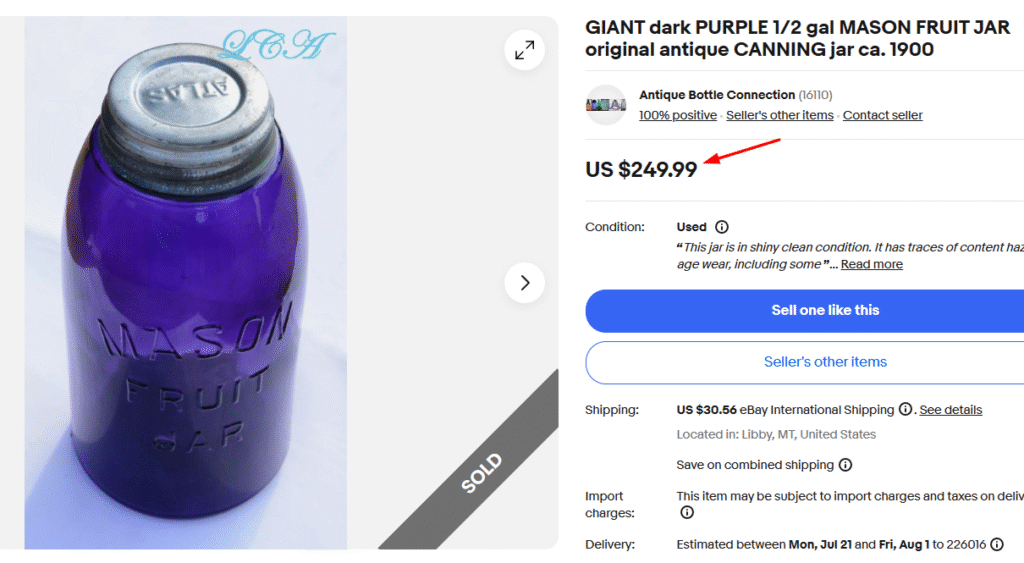
- Brand: Unbranded
- Color: Dark Purple
- Embossment/Marking: Mason Fruit Jar
Purple mason jars are absolute unicorns! Purple glass indicates pre-WWI manufacturing and was initially an error caused by manganese in the glass reacting to sunlight – so these jars were accidental, making them super rare!
Atlas jars in dark purple colors like this command much higher prices than common clear or aqua versions. Plus, the large half-gallon size makes it even more special. Rare colors combined with large sizes can fetch upwards of $300!
10. Strittmatter’s Pure Honey Mason Jar
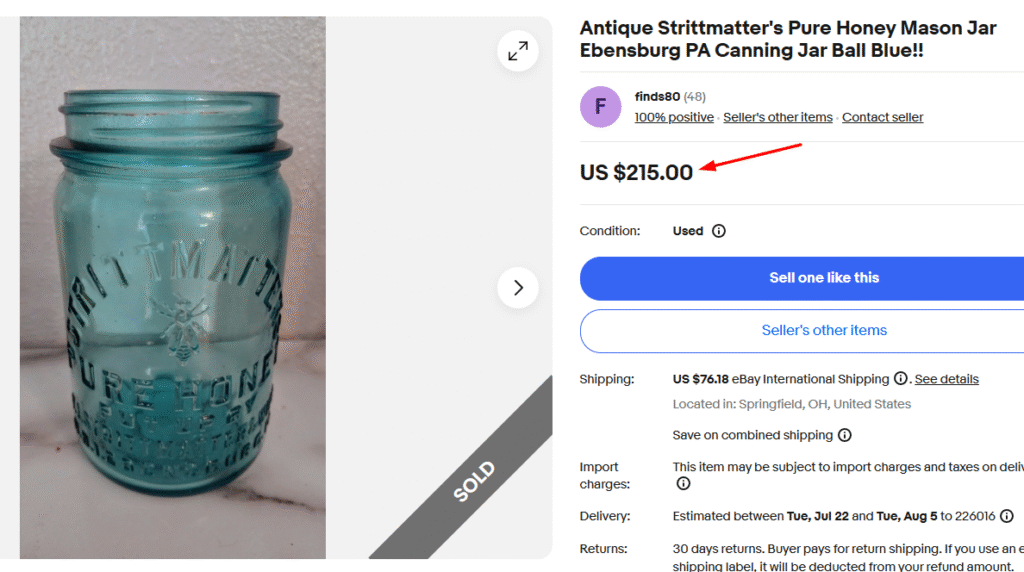
- Brand: for F.J. Strittmatter & Wife
- Color: Blue
- Embossment/Marking: “Strittmatter’s/Put up by/F.J. Strittmatter & Wife”
This aqua blue Mason jar was made for F.J. Strittmatter & Wife from Ebensburg, Pennsylvania, around 1908-1920! Apparently, this is a honey jar and features a cute embossed honey bee on the front!
Apparently, F.J. had five wives and just put “& Wife” on the jar so he wouldn’t have to keep changing the mold! You’ll see the “Strittmatter’s/Put up by/F.J. Strittmatter & Wife” embossing on each jar. These rare honey jars bring between $80 and $300 today.
11. Antique Wax Sealer Mason Jar
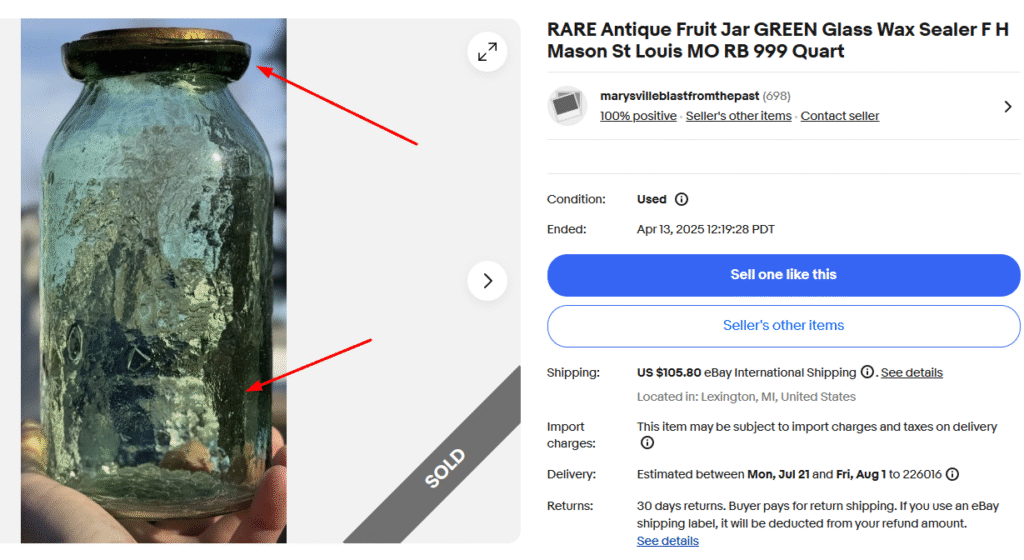
- Brand: Frederick Heitz Glass Works
- Color: Green
- Embossment/Marking: “F.H./6” on the bottom
This jar is truly antique! Why? Because it features the unique wax seal closure! You will also find the “F.H.” marking, indicating it’s a piece from Frederick Heitz Glass Works in St. Louis, Missouri (1883-1898)!
The rare green color makes this jar extra special, adding to its value which reached $500! Wax sealers were competitors to the threaded Mason jars and used wax around the rim to create the seal. But there aren’t many pieces available, making them super rare!
12. Mason’s Union Fruit Jar
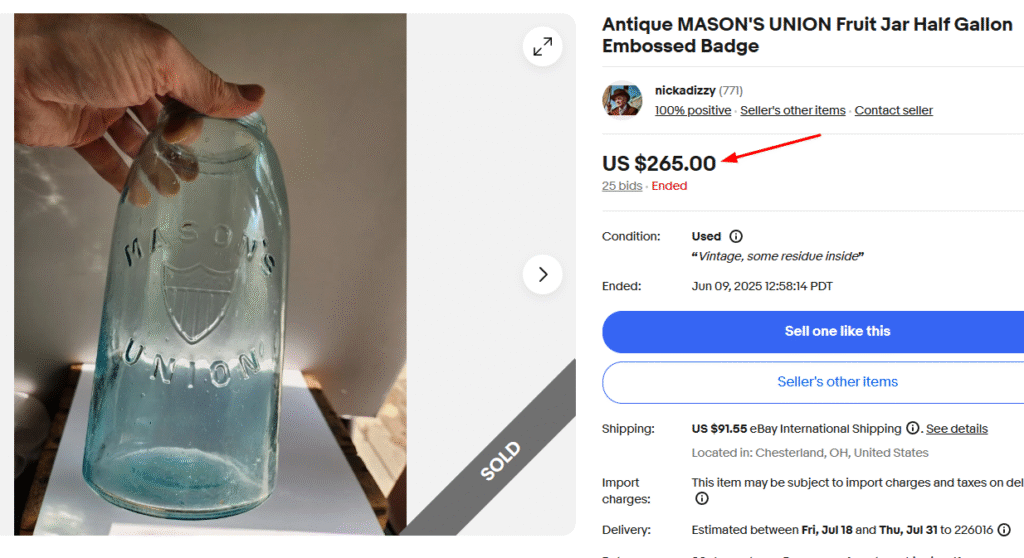
- Brand: Unbranded (Union)
- Color: Aqua
- Embossment/Marking: “Mason’s/Union”
Large Mason jars are always valuable, like this half gallon jar! Apart from the size, what makes this tall aqua mason jar worth over $250 is the unique “MASON’S UNION” embossment and the prominent shield badge!
These markings indicate the jar could belong to a specific regional company or union that contracted for these jars. Since there are not many Union Mason jars around, this one is a rare find!
13. 1890s Red Wing Union Stoneware Pottery Mason Fruit Jar
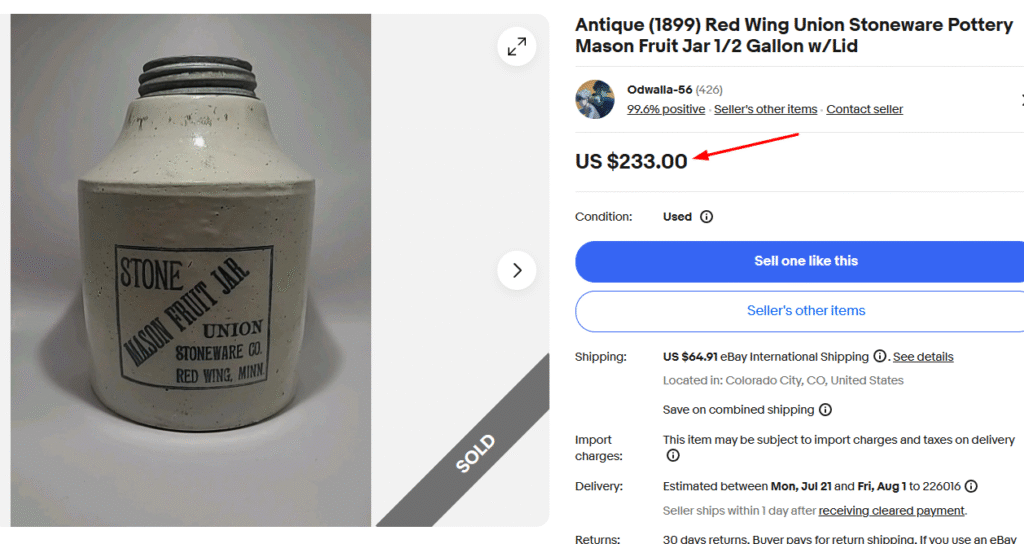
- Brand: Red Wing Union Stoneware Co.
- Color: Cream
- Embossment/Marking: “Stone/Mason Fruit Jar/Union/Stoneware Co./Red Wing, Minn”
Red Wing Union Stoneware mason jars from Minnesota are highly collectible, with large sizes like half-gallon and gallon fetching $200-250 in mint condition! These stoneware jars were made by Union Stoneware Co. starting in 1894, making them super antique!
You’ll find the “PAT JAN 24 1899” marking at the bottom and the distinctive blue label and crisp stenciling on the front, which makes this an authentic piece. Unlike glass jars, authentic pottery Mason jars are much rarer today!
14. Rare Double Seal Mason Fruit Jar
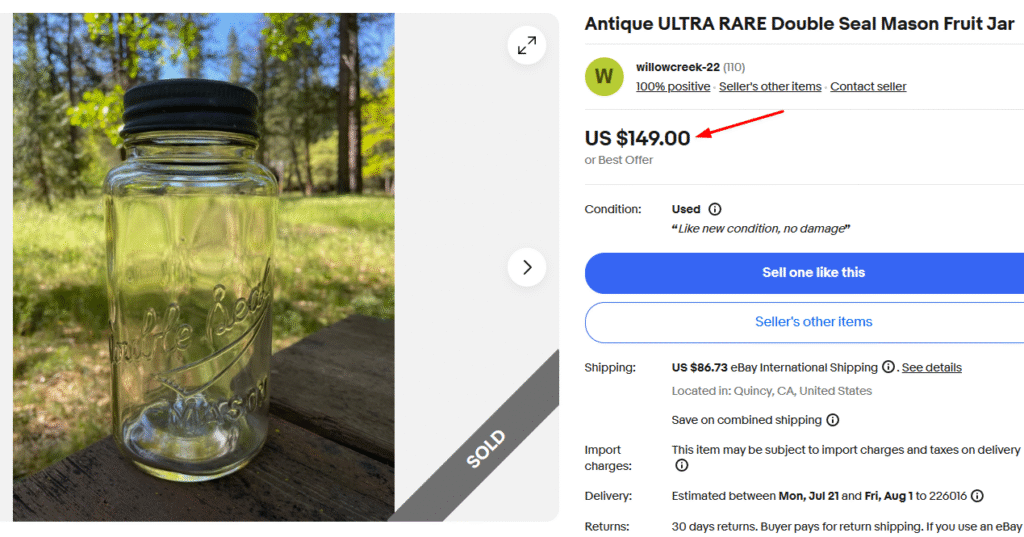
- Brand: Unbranded
- Color: Clear
- Embossment/Marking: “Double Seal/Mason”
What makes this clear glass jar special is its double seal mechanism – featuring a flat metal disc with a rubber gasket and a screw-on metal lid. The jar itself features the “Double Seal/Mason” embossing on the front!
Double seal technology was developed to create better airtight storage, making these jars quite innovative for their time and collectible today!
15. Mason’s Patent Error Jar

- Brand: Unbranded
- Color: Aqua Blue
- Embossment/Marking: “Mason’s/Patent/Nov 30th/1885”
As I already told you, production errors can make any common jar rare and collectible, and this is the example! It’s a Mason’s patent jar but with the reversed date, “1885” instead of “1858.”
Other manufacturing errors on Mason patent jars, like backwards numbers or letters or misspellings, can also make them much more interesting and valuable. That’s why this aqua Mason realized $100 despite being in a common color and small size!
16. Atlas Special Mason Jar
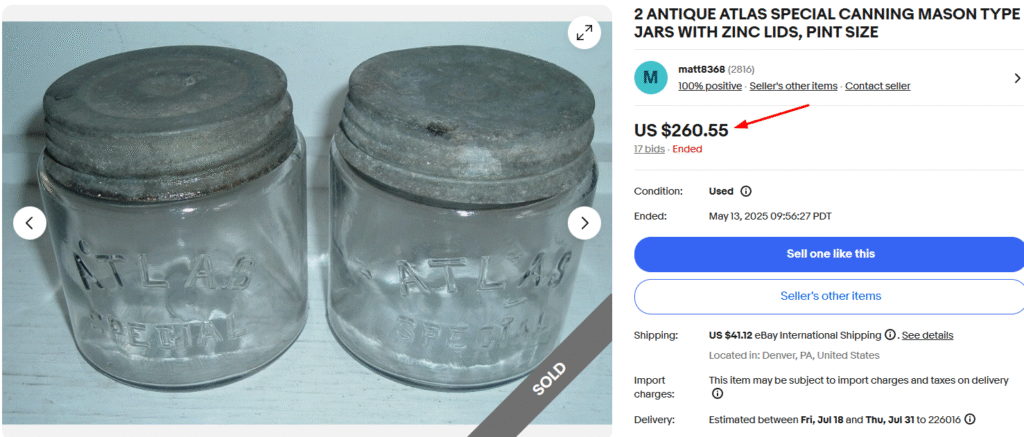
- Brand: Atlas
- Color: Clear
- Embossment/Marking: “Atlas/Special”
Atlas Special Mason jars are easy to identify because they clearly say “Atlas Special” right on them. These square jars came in multiple sizes and used antique rubber seals rather than modern lids.
Atlas Special jars typically sell for $15-$80 individually, but pairs can command higher prices, like this set sold for $260! Also, Special Mason jars in rarer colors, such as blue and amber, are extremely rare and can fetch up to $500!
17. Atlas Cornflower Blue Strong Shoulder Mason Jar
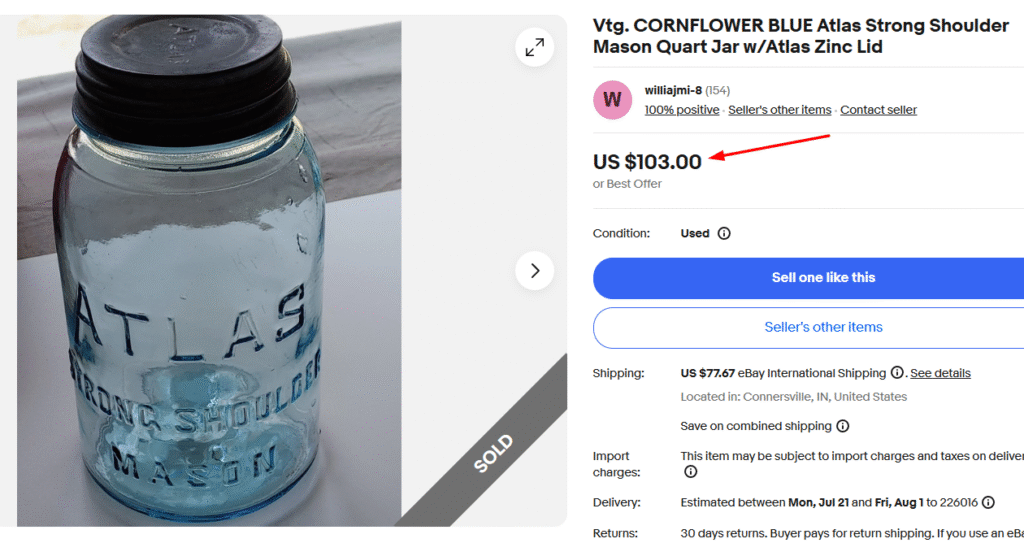
- Brand: Atlas Jars
- Color: Cornflower Blue
- Embossment/Marking: “Atlas/Strong Shoulder/Mason”
Cornflower blue Atlas Strong Shoulder Mason jars are among the most collectible Atlas jars you can find, with some selling for up to $125-130! Atlas made these jars from the 1920s to the 1940s, named “strong shoulder” for the unique design to prevent breakage during sealing!
Because of their popular design and original zinc lids, even common blue Atlas Strong Shoulder Mason jars can easily be worth up to $100, even more for larger sizes, rarer colors, and better condition.
How to Know If an Old Mason Jar Is Valuable?
So there we have it, some rare jars to find! But if you’ve already found a rare jar that’s not in this list, here’s how you can find out whether or not it’s valuable!
Generally, the actual worth of an antique Mason jar comes down to a few key factors, with rarity and condition being the most important ones.
Condition of the Jar
It’s no rocket science that an old Mason jar in perfect shape will always beat a damaged one in value. But how do you assess the condition? Here are the key things to look for:
- Chips and Cracks: These flaws kill value fast. Even tiny nicks or hairline fractures can seriously hurt what a jar’s worth. The lip is especially vulnerable since that’s where most damage happens.
- Cloudiness: Cloud or “sick” glass happens because of mineral deposits (usually from being buried). It happens inside the glass and is tough to remove, thus lowering the value of a jar considerably.
- Missing Lids: The presence of the original lids means a lot for valuing a Mason jar. Jars with intact lids (especially in good condition) can be 20-30% more valuable than those without lids.
Rarity Factors
If there’s something that matters as much as or more than condition, it’s rarity – it drives the big money. And here’s what really makes a jar rare:
- Errors: In case of vintage jars, errors are holy grails! Common errors, such as misspellings in the embossing (like “Masn’s” instead of “Mason’s”), double-stamped logos, or other manufacturing mistakes, make a common jar rare and expensive!
- Limited Production: Collectors highly seek jars made only for a short time or in small batches. The “Van Vliet” and “The Chief” are perfect examples of rare, valuable jars.
- Unique Color: The rarer the color, the higher value a jar holds! For Mason jars, some of the rarest colors are cobalt blue, deep greens, and black. These examples can actually bring hundreds or even thousands of dollars.
- Unique Shape: Most jars have a round body and a narrower neck, which is common! If you find a Mason jar with a unique shape, like the offset “Marion Jar” with its unusual design, it can make collectors compete to own them, offering insane prices.
Size of the Jar
Simply put, the larger the jar, the higher its value! Standard quart jars are the most common sizes that sell for average prices of $15-$150 for common jars.
On the contrary, half-gallon and gallon jars are much rarer and more valuable because they were harder to handle; finding one in good condition is quite difficult!
Then there are store Miniature jars, which are often used for samples or promotions. Collectors love these, too!
Your Guide to Spotting Real Vintage Mason Jars!
Let’s get into some details. When you’re looking at a Mason jar, you need to check five key things to confirm whether it’s a real vintage item, a replica, or a fake:
The Unmistakable Brand and Markings
This is your most important clue. The company name and logo tell you almost everything you need to know about the age and value of a mason jar. But reading these markings can also get a bit tricky, as companies changed their logos multiple times over the years.
Here are some popular Mason jar manufacturers and their key markings/embossments:
Ball Jars
Ball Corporation is one of the biggest names in the Mason jar world. The earliest Ball jars (1885-1886) say “B,B,G,M,Co.” for “Ball Brothers Glass Manufacturing Company.” These jars were made in Buffalo, New York.
From 1900 to 1910, Ball used a script logo with an underline that looks like a cursive “L,” aka the “Triple L” logo. The most common Ball jars say “Ball Perfect Mason” and were made from 1913 into the 1960s. These are still collectible, especially in rare colors.
Atlas Jars
Made by Hazel-Atlas Glass Company, Atlas jars are recognizable by names like “Atlas Strong Shoulder Mason” or “Atlas E-Z Seal.” Here are the most common embossments you’ll find on Atlas jars:
- “Atlas Strong Shoulder Mason” on jars with reinforced ridge to prevent cracking
- “Atlas E-Z Seal” on the lightning-style closure with wire bail system
- “Atlas Special Mason”
- “Atlas Mason’s Patent” on jars that referred to the original Mason patent
- “Atlas Good Luck” on square-shaped jars with this unique name
- “H-over-A” trademark, with a large “H” with an “A” underneath it, on authentic Hazel-Atlas jars made between 1902 and 1964.
Kerr Jars
Kerr’s earliest jars from 1915 just said “Kerr Economy” in simple block letters. But by the 1920s, you’ll see the classic “Kerr Self-Sealing” embossed on the front, often with “Trademark Reg” or “Reg. U.S. Pat. Off.” underneath.
You’ll also find patent dates, like “Pat. 1915,” “March 3, 1903,” or “Nov 18, 1913” on many examples. Some post-1969 examples may also show “AHK” on the bottom for Alexander H. Kerr. The wide-mouth variations often say “Kerr Wide Mouth Self-Sealing”
Mason’s Patent Jars
Apart from the above key players, you’ll find dozens of different companies that made jars with “Mason’s Patent Nov 30th 1858” embossed on them. These reference John Mason’s original patent, but were made for decades after 1858.
Other key signs of these original Mason jars are the hand-finished ground lip, especially in early ones (1858-1900). Also, these jars typically feature a zinc cap screwed down onto a rubber ring on the jar shoulder!
The Physical Appearance (Size & Shape)
Early Mason jars looked quite different from the standardized containers we see today. Before 1900, jar shapes were all over the place – some had bigger bottoms, others weren’t quite symmetrical, and many had unique proportions.
But later on, Mason jars came in standard sizes: half-pint, pint, quart, and half-gallon. But actually, it’s the weird sizes that bring the most money. Generally, larger sizes are much rarer because fewer were made.
The Glass Color
When it comes to Mason jar identification, color can be a key clue. Let me break down what different jar colors actually mean:
- Aqua is what you’ll see most on older Mason jars. That blue-green tint comes from the iron content in the sand they used to make glass back then.
- Clear glass is quite common today, but it only became popular after 1900 when manufacturing got better at removing impurities.
- Amber ranges from pale honey to deep molasses brown. They used this color for light-sensitive contents since it blocks UV rays.
- Green comes in various shades from light olive to deeper emerald. True green Mason jars are actually less common than you’d think compared to aqua.
- Amethyst is clear glass that turned pale purple from sun exposure. This happens because of manganese, a decolorizing agent they used before World War I.
- Cobalt Blue and Black are exceptionally rare and worth serious money to collectors.
Sometimes you’ll find jars with swirled colors or streaks of different hues mixed in the glass. These weren’t intentional – they happened when different colored glassed were mixed in the furnace. Such error pieces are a big win!
Glass Quality & Features
The glass itself is a true indicator of authenticity. It shows certain features that will help you quickly confirm whether or not it’s vintage and how old it is! Here are the key things to look for:
Seams
Seams are your biggest clues for old jars. Before automatic glass-blowing machines came along around 1915, jars had seams that stopped at the neck. If the seam runs all the way up and over the lip, it’s machine-made and newer.
Some very early mouth-blown jars don’t have side seams at all as they were hand-blown; they have pontil marks at the bottom instead.
Bubbles and Imperfections
While these sound like red flags, imperfections like small bubbles, waves, or that “whittled” texture are actually good signs for age. They show older manufacturing processes, confirming that your Mason jar is vintage.
The glass in modern jars is flawless and uniform – too perfect, really.
Closure/Lid Types
Notice how the jar closes – the closure style can actually tell you about its age. Here are the common closures and lid types found on real Mason jars:
- Screwtop Zinc Caps with milk glass liners were the original companion to Mason’s threaded jars and stayed standard for decades.
- Glass Lids with Wire Bails got popular in the late 1800s and early 1900s. These have glass lids held by wire clamps – the “Lightning” jar is the classic example.
- Two-Piece Metal Lids and screw-on bands were introduced by Kerr in 1915. Ball adopted them later, and they became the industry standard.
Base Clues
The base of a Mason jar can also hold significant identification clues. You may find:
- Mold Numbers: You’ll often see numbers from 0 to 15 embossed on the bottom. But these aren’t dates – they’re mold identification numbers. Each glassmaking machine had multiple molds, and numbers helped track which mold was producing defective jars.
- Maker’s Marks: In some jars, you may find the maker’s mark on the bottom. Look for symbols like the “H-over-A” for Hazel-Atlas or various manufacturer initials or full names, such as “JP Barstow.”
- Pontil Evidence: Pontil marks are rough, raised spots left where the pontil rod was! The presence of these marks indicates an authentic and antique hand-blown mason jar.
Final Words
The difference between a valuable vintage Mason jar and a reproduction or fake often comes down to tiny details. But now you know what to look for: the logo variations, the glass characteristics for authenticity, the closure systems, and the color combinations that add rarity to these glass collectibles!

